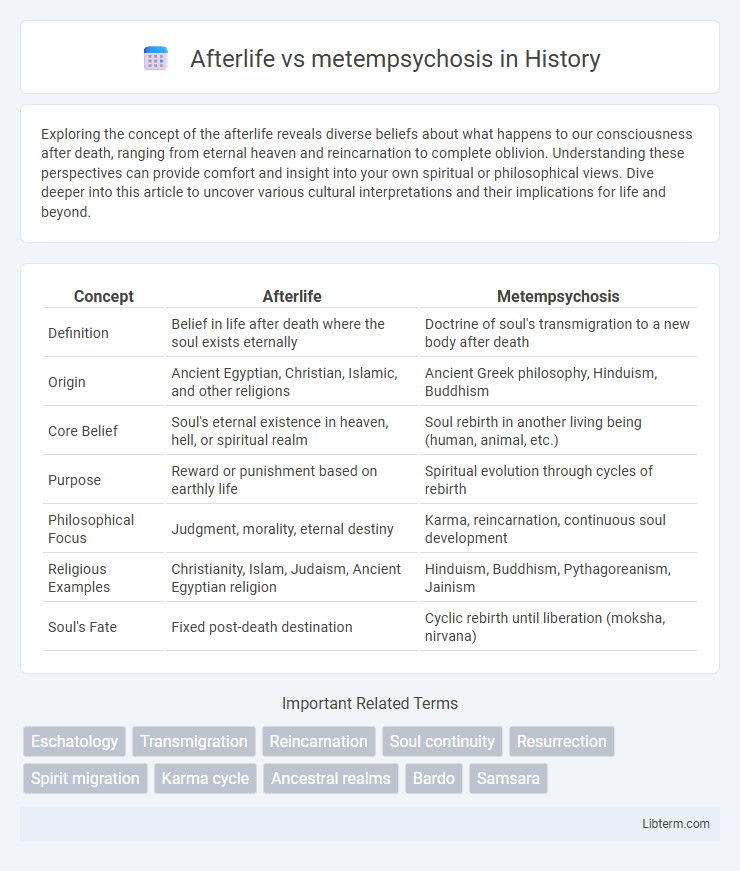Exploring the concept of the afterlife reveals diverse beliefs about what happens to our consciousness after death, ranging from eternal heaven and reincarnation to complete oblivion. Understanding these perspectives can provide comfort and insight into your own spiritual or philosophical views. Dive deeper into this article to uncover various cultural interpretations and their implications for life and beyond.
Table of Comparison
| Concept | Afterlife | Metempsychosis |
|---|---|---|
| Definition | Belief in life after death where the soul exists eternally | Doctrine of soul's transmigration to a new body after death |
| Origin | Ancient Egyptian, Christian, Islamic, and other religions | Ancient Greek philosophy, Hinduism, Buddhism |
| Core Belief | Soul's eternal existence in heaven, hell, or spiritual realm | Soul rebirth in another living being (human, animal, etc.) |
| Purpose | Reward or punishment based on earthly life | Spiritual evolution through cycles of rebirth |
| Philosophical Focus | Judgment, morality, eternal destiny | Karma, reincarnation, continuous soul development |
| Religious Examples | Christianity, Islam, Judaism, Ancient Egyptian religion | Hinduism, Buddhism, Pythagoreanism, Jainism |
| Soul's Fate | Fixed post-death destination | Cyclic rebirth until liberation (moksha, nirvana) |
Understanding the Afterlife: Core Beliefs
Afterlife beliefs often center on the soul's journey post-death, emphasizing destinations such as heaven, hell, or spiritual realms based on moral conduct. Metempsychosis, or reincarnation, involves the soul's rebirth into new bodies across lifetimes, reflecting karma and spiritual evolution. Core beliefs in the afterlife highlight judgment and eternal consequences, whereas metempsychosis underscores cyclical existence and continuous growth through multiple incarnations.
Metempsychosis Defined: Origins and Philosophy
Metempsychosis, rooted in ancient Greek philosophy, denotes the transmigration of the soul from one body to another, implying a cyclical process of rebirth. This concept contrasts with the afterlife notion, which typically presents a singular, eternal existence beyond death, often in a heaven or hell. Prominent philosophers such as Pythagoras and Plato shaped the doctrine of metempsychosis, emphasizing the soul's purification through successive lives and moral development.
Historical Perspectives on Life After Death
Historical perspectives on life after death vary widely, with afterlife traditions emphasizing eternal existence in realms like heaven or hell, rooted in religious doctrines such as Christianity and Islam. Metempsychosis, prominent in ancient Greek philosophy and Hinduism, posits the transmigration of the soul through cycles of rebirth until spiritual liberation is achieved. These contrasting beliefs reflect diverse cultural understandings of consciousness continuity and moral consequences beyond physical death.
Major Religions: Afterlife vs Metempsychosis
Major religions differ significantly in their beliefs about the afterlife versus metempsychosis; Christianity and Islam emphasize a definitive afterlife involving heaven or hell based on divine judgment, whereas Hinduism and Buddhism endorse metempsychosis, the continuous cycle of rebirth or reincarnation influenced by karma. In Christianity, the soul's eternal fate is fixed post-mortem, while Hinduism describes samsara, an ongoing process where the soul transmigrates until achieving moksha, liberation from the cycle. Buddhism rejects a permanent soul but supports rebirth through a causal continuum, contrasting sharply with the linear afterlife concept prevalent in Abrahamic faiths.
Cultural Interpretations Across Civilizations
Afterlife beliefs manifest in diverse cultural interpretations, ranging from the Egyptian concept of the soul's journey through the Duat to attain eternal life, to the Hindu principle of metempsychosis involving the soul's reincarnation across lifetimes. Ancient Greek metempsychosis reflects a cycle of rebirth where the soul transmigrates into new bodies, emphasizing moral consequences, while many Abrahamic traditions emphasize a singular afterlife destination such as heaven or hell. These varying perspectives reveal how civilizations intertwine religious doctrines, ethics, and cosmology to understand existence beyond death.
Philosophical Arguments: Consciousness Continuity
Philosophical debates on afterlife and metempsychosis critically examine the continuity of consciousness beyond physical death. Afterlife theories often posit a persistent, individualized consciousness surviving bodily demise, whereas metempsychosis suggests the transmigration of the soul into a new body, emphasizing cyclical rebirth. Discussions center on identity preservation, questioning whether consciousness remains the same entity or transforms through successive existences.
Science and the Question of Posthumous Existence
Scientific inquiry into the afterlife explores empirical evidence for consciousness beyond death, often contrasting traditional religious beliefs with measurable phenomena like near-death experiences and brain activity cessation. Metempsychosis, or reincarnation, proposes a cyclical soul migration supported by anecdotal case studies and cross-cultural reports, yet lacks definitive scientific validation. Current research emphasizes neurological and psychological frameworks, challenging metaphysical claims while acknowledging the enduring human quest to understand posthumous existence.
Personal Experiences and Anecdotes
Personal experiences in afterlife beliefs often include near-death experiences where individuals report sensing a peaceful presence or seeing a bright light, which reinforces faith in life after death. In metempsychosis, anecdotes frequently involve memories of past lives or reincarnation claims, where people recall specific details from previous existences, supporting the idea of soul migration. Both concepts rely heavily on subjective testimonies that shape cultural and spiritual understandings of life beyond death.
Moral Implications: How Beliefs Shape Behavior
Beliefs in the afterlife often promote moral behavior through the promise of reward or punishment, motivating individuals to adhere to ethical codes to secure a favorable outcome. In contrast, metempsychosis, or reincarnation, encourages ethical living by emphasizing the continuous cycle of souls and the consequences of one's actions across multiple lifetimes. These differing views shape societal values and personal responsibility, influencing how individuals perceive justice and moral accountability.
Modern Debates and Future Perspectives
Modern debates on afterlife versus metempsychosis concentrate on the empirical evidence and philosophical implications regarding consciousness continuity after death. Neuroscientific advancements challenge traditional afterlife concepts, promoting metempsychosis as a framework that aligns with theories of energy transfer and consciousness transformation. Future perspectives emphasize interdisciplinary research combining quantum physics, cognitive science, and metaphysics to explore the plausibility of soul migration and post-mortem existence.
Afterlife Infographic

 libterm.com
libterm.com